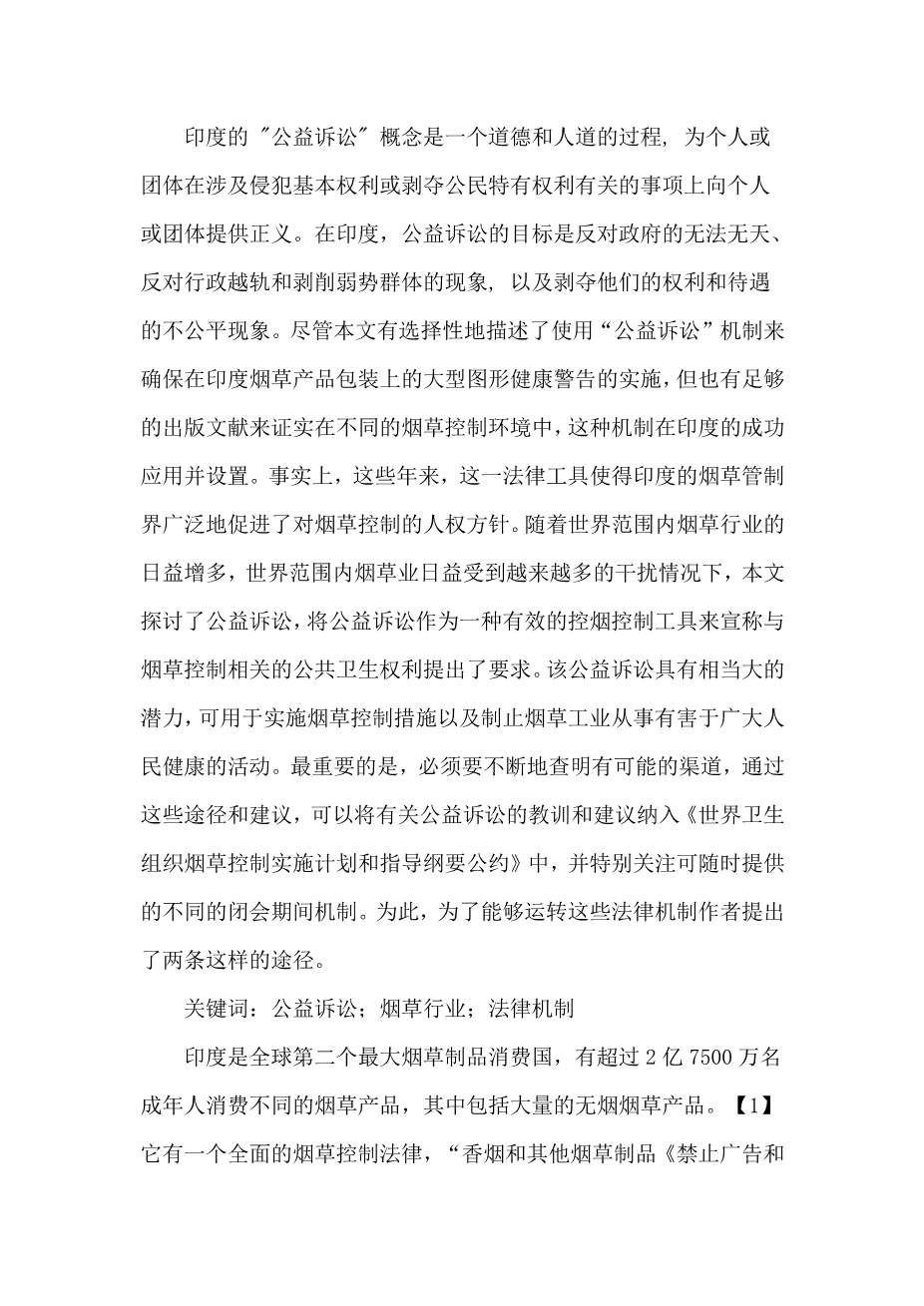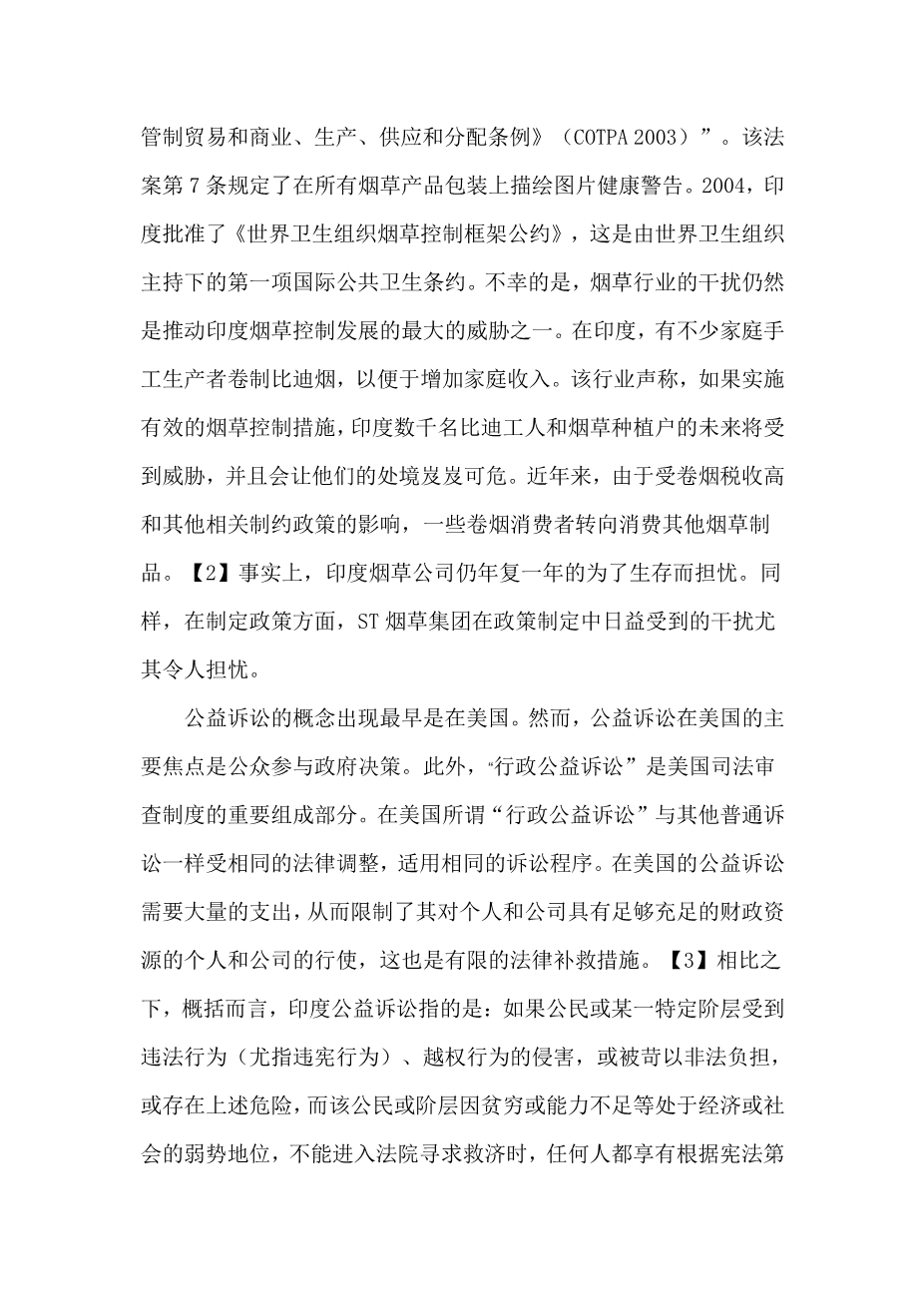The Indian notion of “Public Interest Litigation (PIL)” represents a moral and humane process for providing justice to an individual or a group in matters relating to infringement of fundamental rights or denial of civil privileges. The goal of PIL in India is to counter governmental lawlessness, administrative deviance, and exploitation of disadvantaged groups by denying them their rights and entitlements. Although this paper selectively describes the use of the PIL mechanism for ensuring implementation of large graphic health warnings on packages of tobacco products in India, there is a sufficient published literature to corroborate the successful use of this mechanism in India in different tobacco control settings. In fact, over the years, this legal tool has allowed the tobacco control community in India, to extensively promote human rights approach to tobacco control. In the wake of growing interference of tobacco industry worldwide, this paper explores PIL as a potent and effective tool for claiming public health rights related to tobacco control. The PIL has considerable potential to be used for enforcement of tobacco control measures and for stopping tobacco industry from engaging in activities which are detrimental to the health of the people at large. It is important to continuously identify potential avenues through which lessons and recommendations pertaining to PIL could be incorporated into the WHO Framework Convention on Tobacco Control implementation plans and guidelines, with special focus on different intercessional mechanisms that are available from time to time. To set the ball rolling, the authors suggest two such avenues
India is the second largest consumer of tobacco products worldwide with more than 275 million adults consuming different tobacco products, including myriad of smokeless tobacco (ST) products.[1] It has a comprehensive tobacco control Act, “the Cigarettes and Other Tobacco Products (Prohibition of Advertisement and Regulation of Trade and Commerce, Production, Supply, and Distribution) Act (COTPA 2003),” in place. Section 7 of this act provides for depiction of pictorial health warnings on packages of all tobacco products. In 2004, India ratified the WHO Framework Convention on Tobacco Control (WHO FCTC), the first international public health treaty negotiated under the auspices of the WHO. Unfortunately, the tobacco industry interference continues to be one of the greatest threats in advancing tobacco control in India. The industry claims that the future of thousands of bidi workers and tobacco farmers across India would be at stake if effective tobacco control measures are implemented.[2] Likewise, the growing interference of ST tobacco conglomerates in policy formulation is particularly worrisome
The concept of public interest litigation (PIL) first emerged in the United States. However, the prime focus of PIL in the United States is on public participation in governmental decision-making. Besides, PIL in the United States requires a great deal of expenditure, thus limiting its exercise to individuals and firms with adequate financial resources, that too in limited legal remedies.[4] In contrast, the Indian notion of PIL represents a moral and humane process in providing justice to an individual or a group in matters relating to infringement of fundamental rights or denial of civil privileges. The goal of PIL in India is to counter governmental lawlessness, administrative deviance, and exploitation of disadvantaged groups by denying them their rights and entitlements. Notably, in India, the Supreme Court rules of locus standi, or the eligibility of a person to invoke the jurisdiction of the courts, are so relaxed that anyone asserting a violation of fundamental rights can file a claim in one of the appellate courts.[4] A PIL in India may be introduced in a court of law either by the court itself (suo motu) or by any public-spirited individual or a nongovernment organization (NGO). Although social and economic rights given in the Indian Constitution under Part IV are not legally enforceable, courts have creatively read these into fundamental rights thereby making them judicially enforceable. For instance, the “right to life” in Article 21 of the Indian Constitution has been expanded to include “right to health.”[5] The substantive recognition of the right to health as essential to living with human dignity has thus allowed the judiciary to directly address human suffering by guaranteeing the social entitlements and conditions necessary for good health. Litigation has played an important role in catalyzing government action on issues for which no specific legal framework existed and often serves as precursor for developing appropriate legal frameworks or better enforcement of existing legal frameworks.[6]
There is ample scientific evidence to suggest the positive impact of health warnings on cigarette packs, including tobacco users#39; intentions to quit, their thoughts about health risks, and their engaging in cessation behavior.[7],[8],[9] Studies indicate that the impact of health warnings depends on their size and design, whereas obscure text-only warnings appear to have little impact, pictorial health warnings that elicit strong emotional reactions are significantly more effective.[10] Although comprehensive evidence on the effectiveness of these warnings on packages of ST products is currently lacking,[11] available research suggests positive impact of such warnings on users of ST product The Government of India was stuck in a long-drawn legal battle with the tobacco industry, once rules and guidelines were published to implement different provisions of COTPA.[14] On the issue of implementing the provisions of section 7 of this act, the judiciary came to the government#39;s rescue when an order was passed by the High Court of the State of Himachal Pradesh on
全文共14518字,剩余内容已隐藏,支付完成后下载完整资料


英语原文共 9 页,剩余内容已隐藏,支付完成后下载完整资料
资料编号:[17389],资料为PDF文档或Word文档,PDF文档可免费转换为Word


